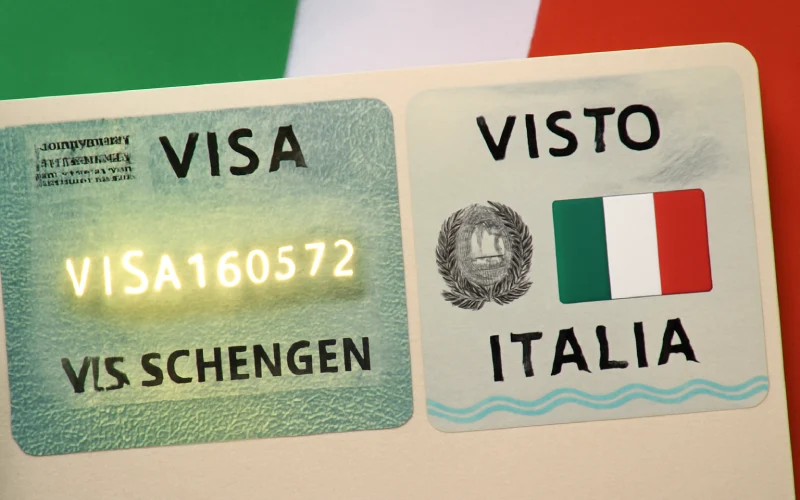So you probably know that the visa for Italy can be like a chess game with the border police. The figures speak for themselves; in 2024, over 11.7 million Schengen visas were applied for, with more than 1.1 million filed for an Italy visa. But 15 percent of Schengen applications were rejected, typically because of technical errors. One common issue is misunderstanding the Italy visa sticker number vs. the Italy visa number, which often leads to mistakes during verification or documentation.
And if you don’t want your name to be on that list, you have to understand what the Italy Schengen Visa sticker number stands for in this context and how it is different from the visa number. These numbers aren’t just details. A misstep, a wrong entry, and you are waiting at the airport with everybody else, far from the streets of Rome.
What is the Italy Visa Sticker Number?
Let’s break it down. Your sticker number is located at the top right corner of your visa sticker. It always begins with “IT” for Italy, followed by a specific string of numbers.
Now, Let’s Understand What the Italy Visa Number is
So here’s the one that matters to you. This is your unique visa ID number in the immigration system, also called the Italy visa application form number. It is also located in the top right corner of your visa sticker, but it is not the same as your sticker number.
Comparison Table: Sticker Number vs. Visa Number
Feature Sticker Number Visa Number
Location Top-right, begins with “IT” Top-right, near the sticker number
Purpose Tracks the physical sticker Immigration system I.D.
Used for Verification by officials only Forms, applications, travel
Format Letters + numbers (9–11 characters) Alphanumeric, varies by issuance
Changes with every visa? Yes Yes
Who uses it Only authorities You, airlines, officials
Risk if confused Extra questions, scrutiny Possible visa rejection or entry denial
Detailed Explanation of All Differences

✦ What Each Number Is Actually For
The sticker is for those on the other side of the glass at the embassy or consulate. It is used to actively help the authorities verify that the sticker in your passport is real and not a forgery. It’s basically a security code. You will never use it at check-in, and no one will ever ask you for it at the border except in cases of suspected fraud. The only moment when the sticker number matters is during internal audits or fraud investigations, and none of that should be of any interest to you unless you are a fraud.
On the other hand, the visa number is what identifies you in the Schengen system. It connects to your application, your biometrics, your travel history, and even your entry and exit dates. Italian immigration will use this number to tag your records, and airlines will use the number to ascertain your boarding privileges. It is employed for everything from extending visas to appeals, making lost passport reports, and reapplying in hopes of getting a new one.
✦ Format and Where to Find Them
Both numbers sit in the top-right corner of your visa sticker, which is exactly why so many people mix them up. The Italy visa sticker number always starts with “IT,” immediately followed by numbers, and usually stands out in bold or larger font. The visa number is also up there but is usually longer, more varied in format, and isn’t always in bold.
If you want to check which is which, look for the code with “IT” at the start; that’s the sticker number. The other alphanumeric string, often just to the left or right, is your visa number.
✦ Who Uses What (and Why It Matters)
Sticker numbers are invisible to your travel process unless you’re suspected of fraud. Immigration officers and consulates use it to make sure the sticker is genuine. Travelers who write the sticker number on forms instead of the visa number usually get flagged or asked to resubmit. It’s a detail most people overlook until their application hits a brick wall.
The visa number, in contrast, is your key to everything. You use it for your Italy visitor visa requirements, for filling out forms at the consulate, for contacting the embassy if your passport is lost, and for any legal inquiries. If you make a mistake and submit the sticker number, your records won’t be found. You’ll join the list of common reasons for Italy visa rejection, and you’ll lose time and money for something that could have been fixed in seconds.
✦ What Happens if You Mix Them Up
Mixing these numbers is not a minor issue. Travelers have missed flights because they put the sticker number on their airline’s check-in system or when filling out the hotel registration in Italy. When officials search for your visa number and can’t find a match, you may be pulled aside, questioned, or denied entry. Repeated mistakes with these numbers can even lead to a “flag” on your record for future Schengen applications.
This is a technical difference, but Italian consulates are strict. They’re on the lookout for fraud and error, and your application can get denied for something as simple as confusing your sticker number with your visa number. Unlike most travel mistakes, this one’s easy to fix if you know what you’re doing.
The Visa Number vs. the Sticker Number: Why It Matters and How It Can Go Wrong
✦ Why Do Both Numbers Change with Each Visa
Every time you’re issued a new Italy visa, you get a new visa number and a new sticker number. Authorities do this to keep each document unique, traceable, and secure. There’s no recycling or reusing. You can’t use your old visa number on a new application, and you can’t track an old visa with a new sticker number. This is a built-in security feature across the entire Schengen system, and it’s one reason applicants get denied for using details from a previous visa.
✦ Real-World Consequences
The system is now so tightly controlled that even a one-character error can put you at the back of the line. If you fill out a new visa application and list your old sticker number as your visa number, you might get a notice for “untraceable document.” If you hand your sticker number to border officials, you’ll be asked for “the real visa number.” In rare cases, it might trigger an investigation into whether your document was altered, even if it’s an honest mistake.
For seasoned travelers, this might sound obvious. But every consulate has a pile of rejected applications that got sent back for nothing more than switching the sticker and visa numbers. It’s technical, but it’s real.
How Italy Handles Visa Number Errors
Italy has a reputation for being tough on visa processing, and even tiny mistakes can result in delays or refusal. If you provide a sticker number where you should enter a visa number, officials may put your application on hold or demand corrections. Mistakes may come back to haunt you in future applications, particularly if you’re perceived as careless or inconsistent.
Visa Sticker vs. Visa Number: Why This Confuses Everyone
Both numbers are in the same location, they appear similar, and they look equally official, so it’s not a surprise that travelers get them mixed up. One is for you, and the other is for law enforcement. With no clear labels, a lot of people assume that the wrong one is important. It is a small thing, with large consequences if gotten wrong.
FAQs About Italy Visa Sticker Number and Visa Number
Where is the visa sticker number located?
Do I need a special visa just for Italy?
What’s the smartest way to avoid Schengen visa rejection?
What is the number of entries on a Schengen visa?
Where can I find my Schengen visa reference number?
Where do I find my visa number?
What is the purpose of the visa stamp?
Conclusion
Confusing your sticker number and your visa number on your Italy visa is not only a mixing up of paperwork. It’s one of those unnecessary errors that dumps thousands of applications each year into the rejection pile. The devil’s in the details, and getting them right is your best hope of enjoying Italy drama-free.






